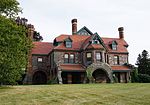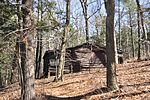Blue Hills State Police Barracks Station H-7
Barracks on the National Register of Historic PlacesBuildings and structures completed in 1904Buildings and structures in Norfolk County, MassachusettsGovernment buildings on the National Register of Historic Places in MassachusettsMilton, Massachusetts ... and 2 more
National Register of Historic Places in Milton, MassachusettsNorfolk County, Massachusetts Registered Historic Place stubs

The Blue Hills State Police Barracks is on Hillside Street in Milton, Massachusetts. It houses the police and patrol offices of the Blue Hills Reservation, a Massachusetts state park administered by the Massachusetts Department of Conservation and Recreation (DCR). The 1+1⁄2-story building was designed by Stickney & Austin and built in 1904 out of Quincy granite. The building is an elongated Cape-style building, with eight bays across and three deep. The roof line is pierced by eight evenly spaced gable dormers and two chimneys.The building was listed on the National Register of Historic Places on September 25, 1980.
Excerpt from the Wikipedia article Blue Hills State Police Barracks Station H-7 (License: CC BY-SA 3.0, Authors, Images).Blue Hills State Police Barracks Station H-7
Hillside Street,
Geographical coordinates (GPS) Address Nearby Places Show on map
Geographical coordinates (GPS)
| Latitude | Longitude |
|---|---|
| N 42.214826 ° | E -71.09312 ° |
Address
State Police Milton
Hillside Street 685
02186
Massachusetts, United States
Open on Google Maps










